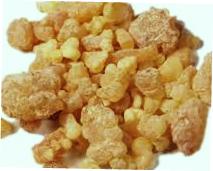
Frankincense Resin and Powder

Herb Info
Frankincense and the oil produced from it has been known for its healing powers and its ability to improve communication with he creator in the Middle East for thousands of years before it was made a gift of to Christ by the Magi. There are over 52 references to it in the Bible. Egyptian records show a great many references to it including its use in cosmetics, perfumes and as an embalming agent. The Chinese used it as part of a treatment for leprosy. Grown predominantly on the Somali coast and
Herb Description
Frankincense Resin and Powder Profile
Also known as:
Boswellia carterii, Olibanum, Indian Franckincense, Arabic Frankincense, and Salai guggal
Introduction:
Frankincense and the oil produced from it has been known for its healing powers and its ability to improve communication with he creator in the Middle East for thousands of years before it was made a gift of to Christ by the Magi. There are over 52 references to it in the Bible. Egyptian records show a great many references to it including its use in cosmetics, perfumes and as an embalming agent. The Chinese used it as part of a treatment for leprosy. Grown predominantly on the Somali coast and parts of the Arabian Peninsula, the resin is obtained by making deep cuts in the trunk of the tree lengthwise. Below this incision a narrow strip of bark is peeled off allowing the sap to run out, and as it touches air it begins to harden. It takes approximately three months to harden into the yellow "tears" that we are used to seeing will be sold at market. The sap is gathered from May until the rain showers start in September.
Constituents:
The venerable herbalist Mrs. Grieve noted that the constituents of frankincense as follows: resins (65%), volatile oil (6%), water soluble gum (20%), bassorin (6-8%), and plant residue (2-4%). The resins contain boswellic acid and alibanoresin.
Parts Used:
Dried resin, collected from stems and trunk.
Typical Preparations:
Powdered resin added to water, tincture, and very rarely as a tea. For internal use, sometimes mixed with myrrh or cress. In aromatherapy, frankincense is compatible with bergamot, cinnamon, clary sage, geranium, grapefruit, jasmine, lavender, lemon, myrrh, neroli, orange, patchouli, pine, rose, sandalwood, tangerine, and ylang ylang. In Ayurvedic medicine, frankincense is combined with turmeric to make teas, tinctures, or encapsulations for treating arthritis and muscle pain.
Summary:
Frankincense is traditionally used to treat coughs. Modern research confirms that it contains phytochemicals that stop the production of leukotrienes that cause constricted airways and inflammation. Frankincense is often described as a stimulant, but its action are only similar to those of stimulants in relieving the symptoms of asthma, bronchitis, colds, and flu. It is currently being researched and used therapeutically in hospitals in Europe
Precautions:
If you take a blood thinning medication such as Coumadin, Plavix, or Trental, do not take frankincense directly (in whole form) by mouth. Frankincense should not be applied to broken or abraded skin.
This information has not been evaluated by the Food and Drug Administration.
This information is not intended to diagnose, treat, cure, or prevent any disease.
For educational purposes only.

